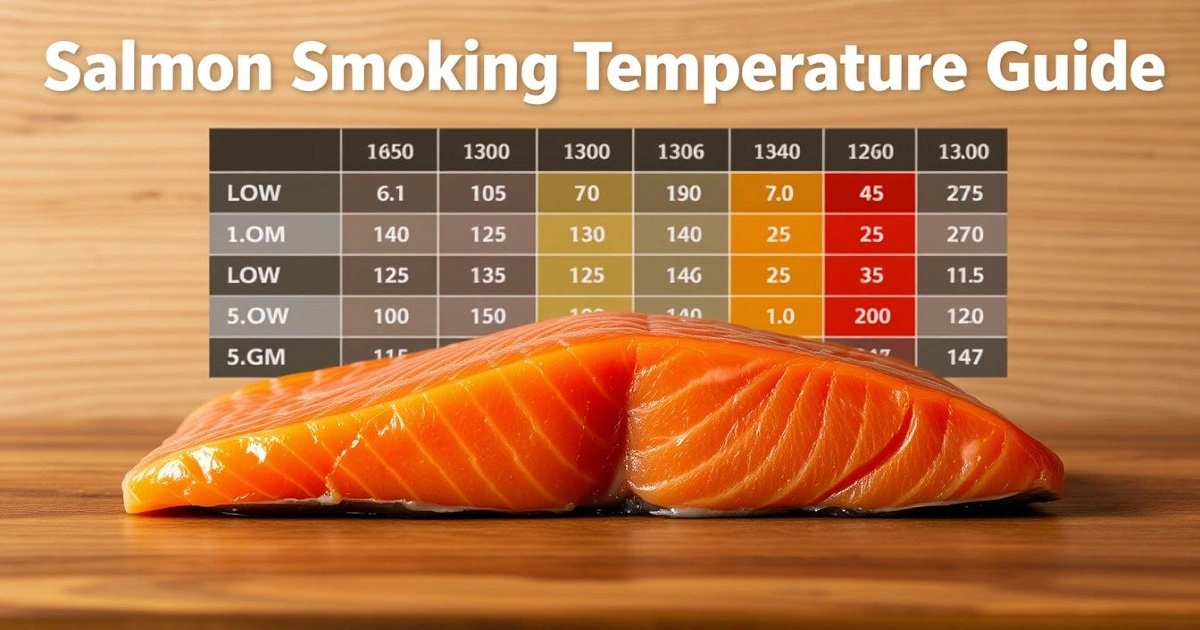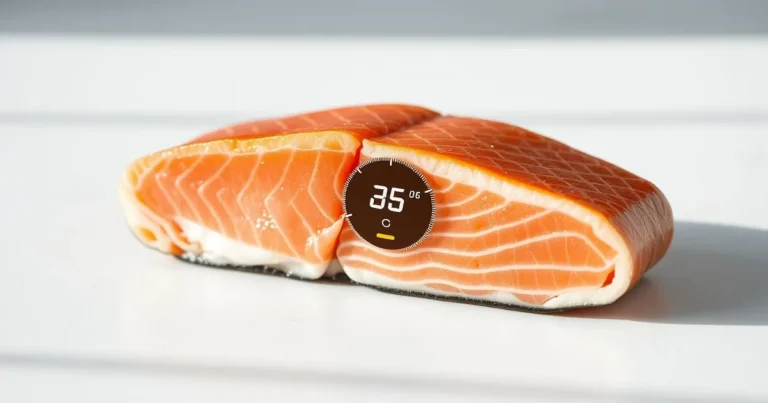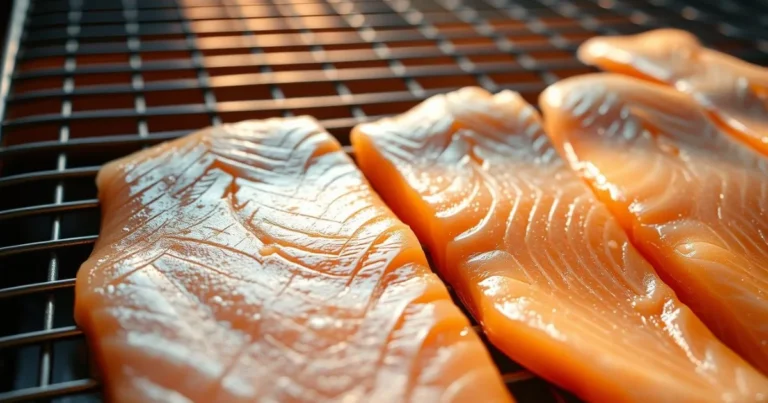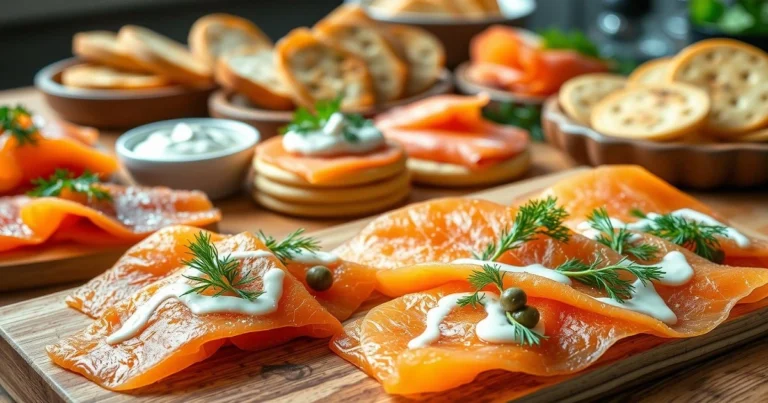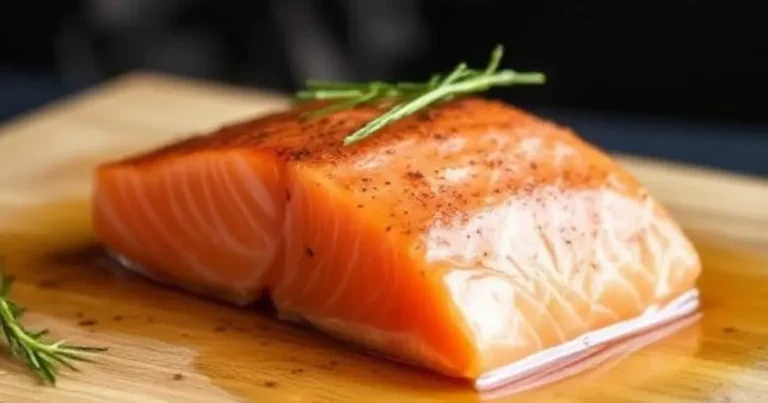What Temperature Should You Smoke Salmon For Best Results?
what temperature for smoked salmon
Smoking salmon needs careful temperature control for the best taste and texture. Knowing the right temperature is key to making a dish that’s both safe and delicious. Home cooks and food lovers must find the right balance of heat and smoke to turn regular fish into a gourmet treat.
The internal temperature of smoked salmon is very important for its quality. Chefs and food experts say that controlling temperature is essential. It helps avoid dryness and makes sure the fish is cooked right. Your smoking method can turn a tender, tasty salmon into a bad meal.
Table of Contents
Understanding the Art of Smoking Salmon
Smoking salmon turns a simple fish into a tasty treat. Learning to smoke salmon opens up a world of flavors and old preservation methods. These techniques have been honed over many generations.
The History of Salmon Smoking
Indigenous groups in the Pacific Northwest started salmon smoking to preserve food. They used these methods to keep fish fresh for long periods. This helped them survive the cold winter months.
Benefits of Smoking Salmon at Home
- Enhanced flavor profile with customizable seasonings
- Cost-effective alternative to store-bought smoked salmon
- Control over ingredient quality and preparation
- Impressive culinary skill to share with friends and family
Hot Smoking vs Cold Smoking Methods
There are two main ways to smoke salmon: hot smoking and cold smoking. Hot smoking is safer and easier for beginners.
| Method | Temperature Range | Cooking Time |
| Hot Smoking | 225-275°F | 1-3 hours |
| Cold Smoking | 68-86°F | 6-12 hours |
Hot smoking ensures your salmon reaches a safe internal temperature while developing a rich, smoky flavor that will impress even the most discerning palates.
Selecting the Perfect Salmon for Smoking
Choosing the right salmon is key for tasty smoked salmon dishes. The fish’s quality affects the flavor, texture, and success of your smoking.
When picking salmon, know the differences between farm-raised and wild types. Each variety adds special qualities to your smoked salmon.
Farm-Raised vs Wild Salmon Options
Your choice of salmon can greatly impact your smoking results. Here’s a comparison to guide you:
- Farm-Raised Atlantic Salmon: Higher fat content, consistent texture
- Wild King (Chinook) Salmon: Rich flavor, deep red coloring, extra flaky texture
- Sockeye Salmon: Lean, intense flavor, ideal for those preferring less fatty fish
Quality Indicators to Look For
When shopping for salmon, look for these quality markers:
- Bright, consistent color
- Firm, elastic flesh
- Fresh, clean ocean smell
- No discoloration or browning edges
Best Salmon Varieties for Smoking
| Salmon Variety | Fat Content | Flavor Profile | Smoking Suitability |
| King (Chinook) | High | Rich, buttery | Excellent |
| Atlantic | Very High | Mild, smooth | Very Good |
| Sockeye | Medium | Intense, robust | Good |
Pro tip: For the best smoked salmon, pick salmon with higher fat content. The fat keeps it moist and adds flavor.
Essential Equipment for Smoking Salmon
Learning to smoke salmon starts with the right tools. You’ll need several key pieces to turn fresh salmon into a tasty treat.
Here are the essential pieces of equipment you’ll need for smoking salmon:
- Smoker or Grill: A dedicated smoker works best, but a standard grill with indirect heat can also work
- Wood Chips or Chunks: Fruit woods like cherry or apple provide exceptional flavor
- Digital meat thermometer for precise temperature tracking
- Aluminum drip pan
- Sharp fillet knife
- Cutting board
For those wondering how to smoke salmon successfully, investing in a quality electric smoker can simplify the process. These smokers offer consistent temperature control, which is crucial for perfectly smoked fish. An electric temperature probe set to 125°F helps monitor internal cooking temperatures accurately.
Professional smokers recommend using a smoker that maintains a steady temperature around 180°F to 225°F. The thickness of your salmon (typically ½ to ¾ inch) will influence smoking time, which ranges from 3 to 6 hours.
Pro tip: Choose equipment that allows you to maintain consistent temperatures for the best smoked salmon results.
What Temperature for Smoked Salmon
Smoking salmon needs precision and careful temperature control. The right temperature turns ordinary fish into a tasty treat. It preserves the salmon’s delicate texture.
When thinking about smoked salmon temperature, focus on two key areas. These are smoker temperature and the salmon’s internal temperature. Experts say consistency is crucial for great results.
Optimal Smoking Temperature Range
The best smoker temperature is between 225°F and 275°F. This range cooks the salmon gently, keeping it moist and flavorful. Here’s a temperature guide:
- Low and slow: 225°F for tender, moist salmon
- Medium heat: 250°F for balanced cooking
- Higher range: 275°F for slightly faster preparation
Internal Temperature Guidelines
It’s important to track the salmon’s internal temperature. This ensures both safety and taste. Different salmon types need slight temperature adjustments:
| Salmon Type | Target Internal Temperature | Cooking Time |
| Wild-caught Salmon | 120°F | Approximately 30-45 minutes |
| Farm-raised Salmon | 125°F | Around 45-60 minutes |
Temperature Control Tips
For perfect smoked salmon, follow these expert tips:
- Use a reliable digital meat thermometer
- Check temperature at the thickest part of the fillet
- Maintain consistent smoker temperature
- Allow for slight temperature variations
Pro tip: Always let your salmon rest for 10-15 minutes after smoking. This lets juices redistribute, ensuring maximum flavor and tenderness.
Preparing Your Salmon Before Smoking
Getting your salmon ready for smoking is key. It can make or break your dish. The process involves several important steps for the best flavor and texture.
First, check your salmon fillet carefully. Remove any pin bones to improve the eating experience. Use tweezers to gently pull out these bones, making sure the fish stays whole.
- Inspect the salmon for pin bones
- Use clean tweezers to remove bones
- Trim any excess fat from the fillet
The brine solution is where the magic starts. Mix:
- 2 quarts of water
- 1 cup of kosher salt
- 1 cup of brown sugar
- 1-2 tablespoons of additional spices
Pro tip: Brine your salmon for 9-72 hours. After brining, pat the fish dry and let it rest on wire racks. This step helps create a pellicle, which makes smoke stick better.
Drying is also crucial. Place the salmon skin-side down in a cool room at 60°F. Let it dry for 90 minutes, but don’t go over 2 hours. This step makes the surface tacky, perfect for holding smoke and seasonings.
The key to exceptional smoked salmon is in the preparation. Take your time, follow each step carefully, and you’ll be rewarded with a delicious, professional-quality result.
The Perfect Brine for Smoked Salmon
Making a great smoked salmon brine is key for rich flavor and moist results. Your brine turns an ordinary fish into a culinary gem.
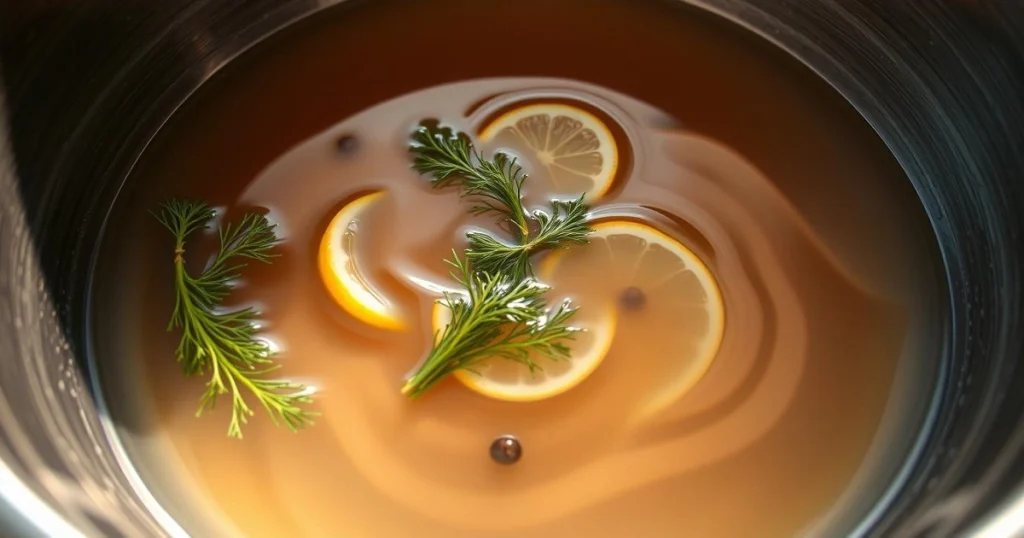
Smoked Salmon Brine Preparation
The best brine mixes salt, sugar, and spices to boost the fish’s taste. Knowing the right amounts lets you achieve top-notch results at home.
Salt and Sugar Ratios
For a perfectly cured brine, use exact measurements. Here’s a guide for a 3.5 to 4.5-pound salmon side:
- 1/2 cup Diamond Crystal kosher salt
- 1/2 cup packed light brown sugar
- Water to fully submerge the salmon
Brining Duration
Brining time is crucial. For most salmon, 5 hours is perfect for flavor without too much salt. Longer brines can be too salty, while shorter ones might not cure well.
Additional Seasonings
| Seasoning | Flavor Profile | Quantity |
| Black Peppercorns | Warm, Spicy | 1 tbsp |
| Fresh Dill | Herbal, Bright | 2 sprigs |
| Garlic Cloves | Robust, Pungent | 2-3 cloves |
Try different herbs and spices to improve your brine. Remember, subtle changes are best – you want to enhance, not overpower, the salmon’s taste.
“A great smoked salmon brine is like a symphony – every ingredient plays a crucial role in creating harmony.” – Culinary Expert
Creating the Essential Pellicle
Learning to smoke salmon starts with making the perfect pellicle. The pellicle is a sticky, glossy layer on the salmon. It helps the smoke stick and makes the flavors better.
To make a great pellicle, you need to dry the salmon right. First, rinse off any extra brine and dry it with paper towels. Then, put the fish on a wire rack in a cool, well-ventilated area.
- Ideal temperature range: Under 65°F (15°C)
- Recommended drying time: 1-4 hours
- Surface condition to look for: Tacky and glossy finish
Creating a good pellicle takes patience and the right environment. You can use a fan to help air move better. Some people even put the salmon in the fridge for better airflow.
Here’s how to know if your pellicle is ready:
- It should feel slightly sticky
- Look for a glossy, gel-like look
- It should be a bit translucent
Pro tip: Don’t over-dry your salmon, as this can create a leathery texture that diminishes the fish’s natural moisture and tenderness.
| Pellicle Formation Factors | Recommended Conditions |
| Temperature | Under 65°F (15°C) |
| Drying Time | 1-4 hours |
| Air Circulation | High, using a fan if needed |
Mastering the pellicle technique will make your smoked salmon taste amazing. It will have a rich, smoky flavor and a great texture that seafood lovers will love.
Wood Selection for Smoking Salmon
Choosing the right wood is key when smoking salmon. Wood gives that smoky flavor that makes smoked salmon so tasty. Not all woods are the same, and your choice can change the taste of your fish a lot.
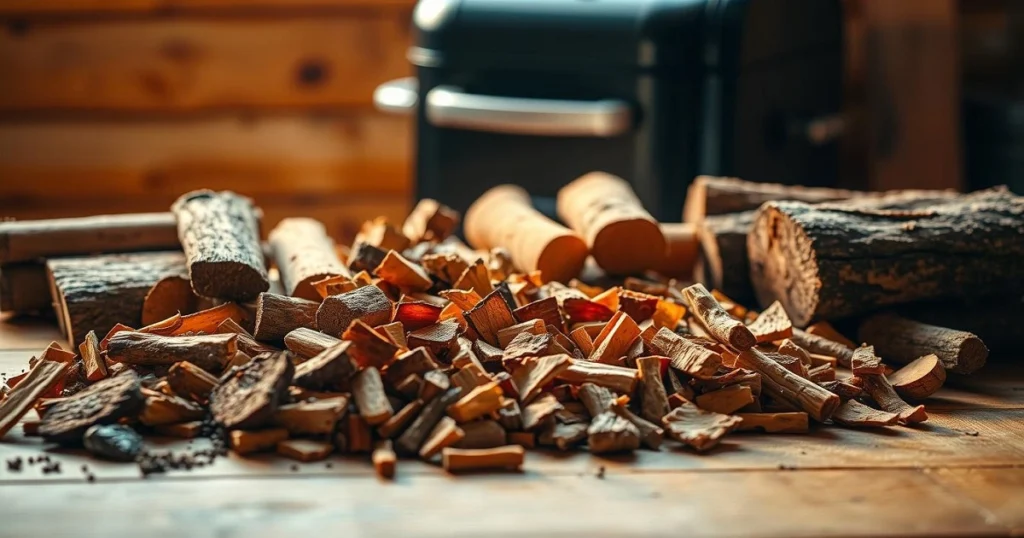
Wood selection for smoking salmon
- Alder Wood: The traditional favorite for salmon, offering a light and sweet flavor
- Apple Wood: Provides a mild, fruity smoke that complements the fish’s delicate taste
- Maple Wood: Delivers a subtle sweetness that enhances the salmon’s natural richness
- Cherry Wood: Creates a slightly sweet and mild smoky profile
To smoke salmon well, you need to know how to use your wood. Use wood chunks or chips that are about three inches in size. Soak your wood chips in water for 30 minutes before use. This helps them burn slowly and evenly, giving you a consistent smoke.
Green wood from fruit trees like apple or pear is best. These woods burn slowly and produce more smoke with less intense heat. This is perfect for getting that perfectly smoked salmon. You can use wood in different forms like pellets, chips, or chunks to change the flavor intensity.
Pro tip: Always use fresh, high-quality wood to ensure the best possible flavor when smoking salmon.
When smoking salmon, keep your smoker temperature between 225°F to 275°F. Use a meat thermometer to check the internal temperature. This ensures the heat stays consistent during the smoking process.
Monitoring Cooking Progress
Getting smoked salmon just right means watching the temperature and timing closely. Knowing how to check your salmon’s internal temperature is key to a tasty, perfectly cooked dish every time.
Time Guidelines for Smoking
The time it takes to smoke salmon depends on its size and thickness:
- 1-2 pound fillets: 45 minutes to 2 hours
- 3-4 pound fillets: 1.5 to 3 hours
Visual Indicators of Doneness
Watch for these signs that your salmon is almost done:
- Color change: It turns from translucent to opaque
- Texture: It becomes flaky but stays moist
- Surface appearance: It gets a rich, glossy look
Temperature Testing Methods
It’s vital to monitor the temperature accurately for the best smoked salmon:
- Use an instant-read thermometer
- Put the probe into the thickest part of the fillet
- Shoot for internal temperatures:
- Medium-rare to medium: 130°F-135°F
- Ideal safe temperature: 145°F
Pro tip: Salmon’s internal temperature might go up 2-5°F while it rests. So, take it out a bit before you reach your target temperature.
Storage and Serving Suggestions
Keeping your smoked salmon fresh is key. It’s all about how you store and serve it. This way, you can enjoy it for weeks.
Refrigeration and Freezing Techniques
There are a few ways to keep your smoked salmon in top shape:
- Refrigerate in an airtight container for 2-3 weeks
- Freeze in sealed packaging for up to 3 months
- Keep wrapped tightly to prevent moisture loss
- Store away from raw food products
Creative Serving Ideas
Make your smoked salmon into something special with these ideas:
- Spread on bagels with cream cheese
- Roll into fresh sushi with cucumber
- Mix into scrambled eggs with Tabasco
- Fold into creamy risotto
- Flake over pasta or rice
Serving Portions and Pairings
Knowing how much to serve is important:
| Portion Size | Serving Recommendation |
| 1 ounce | Approximately 1 slice |
| 3-4 ounces | Sufficient per person |
| 1 pound | Serves 4-5 people |
Pro tip: For transport, use a cooler with ice packs to keep your smoked salmon fresh and delicious.
Conclusion
Smoking salmon is a delicate art that requires the right temperature. Your journey starts with choosing the perfect fish. Then, you aim for that perfect smoky taste.
The ideal temperature for smoking salmon is between 145°F and 150°F. This ensures your salmon is cooked just right and tastes amazing.
The temperature you choose affects the salmon’s final taste. Hot smoking at 145°F gives a firmer texture. Cold smoking at lower temperatures makes it silky.
West Coast fans prefer hot smoked salmon. East Coast lovers enjoy the smooth cold-smoked variety.
Success in smoking salmon depends on controlling temperature and paying attention to detail. Try different wood chips like applewood. Keep an eye on the internal temperature and tweak your method as needed.
With practice, you’ll make smoked salmon as good as a restaurant’s. And you’ll do it affordably and with fun.
Smoking salmon is a rewarding art. With the right knowledge, you’re set to start your own salmon smoking journey.
FAQ
What is the ideal temperature range for smoking salmon?
To smoke salmon right, keep the temperature between 225-275°F. This ensures the fish cooks evenly and absorbs smoky flavor well. Keeping the temperature steady is key for moist, tasty smoked salmon.
How long does it take to smoke salmon?
Smoking time varies with fish thickness and temperature. It usually takes 2-4 hours. The goal is to reach an internal temperature of 145°F for safety, not just time.
What type of salmon is best for smoking?
King salmon and Sockeye are top picks for smoking. They have lots of fat and flavor. Wild-caught salmon tastes better, but farm-raised can also be great.
Do I need to brine salmon before smoking?
Yes, brining is a must. A simple brine with salt and sugar cures the fish, adds flavor, and keeps it moist. Brining for 2-4 hours greatly improves the smoked salmon’s taste and texture.
What wood is best for smoking salmon?
Alder wood is the classic choice for salmon, offering a mild, sweet taste. Apple, maple, and cherry woods are also great. Each wood gives a unique flavor, so try different ones to find your favorite.
How do I know when my smoked salmon is done?
Check with an instant-read thermometer for an internal temperature of 145°F. Look for a firm texture, opaque flesh, and a golden-brown color. The fish should flake easily but stay moist.
How long can I store smoked salmon?
Store smoked salmon in an airtight container in the fridge for 3-7 days. Freeze it for up to 3 months for longer storage. Always wrap it well to avoid freezer burn.
What’s the difference between hot and cold smoking salmon?
Hot smoking cooks the fish at 225-275°F, making it safe and fully cooked. Cold smoking is done below 90°F and needs curing to be safe. For beginners, hot smoking is safer.
Can I smoke salmon on a regular grill?
Yes, you can smoke salmon on a regular grill. Use indirect heat and wood chips in a smoker box or foil. Keep the temperature low and use a thermometer to check both grill and fish temperatures.
Do I need to remove pin bones before smoking?
Yes, remove pin bones before smoking. Use tweezers or needle-nose pliers to pull them out. This makes the salmon safer to eat and prevents choking hazards.

